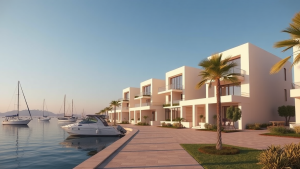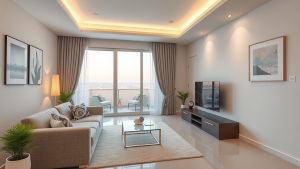Essential accessible home features for retirees: enhancing safety and comfort
Creating a comfortable and safe living environment is vital for retirees. As individuals age, they may experience changing physical abilities, making home accessibility an important consideration. Implementing essential accessible home features can enhance both safety and comfort, allowing retirees to maintain independence. Here are some key features to consider when modifying a home for accessibility.
Wide doorways and hallways
Ensuring that doorways and hallways are wide enough is crucial. A width of at least 36 inches allows for easy navigation, especially for those using walkers or wheelchairs. This simple modification prevents frustration and promotes mobility throughout the home.
No-step entries
Eliminating stairs can significantly enhance accessibility. A no-step entry at the main entrance of the house provides an easy entry point for retirees. It is also helpful when carrying groceries or moving household items. Consider ramps or sloped pathways that are sturdy and comply with safety standards.
Lever-style door handles
Traditional doorknobs can be challenging for retirees who may have arthritis or limited hand strength. Replacing doorknobs with lever-style handles can make opening doors easier. These handles are often more ergonomic and require less force to operate, allowing for greater independence.
Non-slip flooring
Flooring can pose a significant slip hazard, especially for seniors. Choose non-slip materials, such as cork, vinyl, or textured tiles. Area rugs, while appealing, should have non-slip backing or be removed entirely to reduce the risk of falls.
Grab bars and handrails
Installing grab bars in bathrooms, hallways, and near steps adds extra support, enhancing safety. Place them next to the toilet and in the shower to assist with standing or transferring. Handrails on both sides of staircases can prevent falls and offer stability to those who may need assistance.
Adjustable lighting
Proper lighting is essential for creating a safe environment. Use adjustable lighting fixtures to ensure illuminating key areas like staircases and hallways. Consider adding motion sensor lights for ease of access, especially during nighttime visits to the bathroom or kitchen.
Bathroom modifications
- Walk-In Showers: Replacing the bathtub with a walk-in shower eliminates barriers. Consider incorporating a seat and handheld showerhead for added convenience.
- Raised Toilet Seats: A raised toilet seat reduces strain when sitting or standing, facilitating a comfortable experience.
- Vanities and Sinks: Opt for vanities with knee space underneath, allowing wheelchair access and easy maneuverability.
Smart home technology
Integrating smart home devices can enhance accessibility for retirees. Voice-activated systems enable control of lights, thermostats, and even locks without the need for manual adjustments. These technologies can improve safety by reducing the need for movement around the house.
Emergency alert systems
An emergency alert system ensures that help is always accessible. A personal alert device allows retirees to call for help with the push of a button. Consider installing alarms that detect smoke, carbon monoxide, and excess water, enhancing overall safety.
Comfortable living spaces
- Adjustable Furniture: Choose recliners or sofas that provide easy access for those with mobility issues.
- Accessible Storage: Organize frequently used items within arm’s reach to limit bending and stretching.
- Temperature Control: Thermostats that are easy to operate help maintain a comfortable living environment throughout the year.
By incorporating these accessible home features, retirees can significantly enhance their quality of life. Comfort and safety are paramount as they navigate daily routines. Making these changes empowers independence and fosters a more enjoyable living experience. Whether building a new home or modifying an existing one, focusing on accessibility is essential in supporting a fulfilling retirement.
The importance of universal design in senior living spaces
The concept of universal design plays a vital role in creating livable environments for seniors. As people age, their needs evolve, and it becomes crucial to cater to those changes in their living spaces. Implementing universal design principles helps make homes more accessible, promoting independence, safety, and comfort for older adults.
One of the key aspects of universal design is its focus on the user experience. Unlike traditional designs that may overlook the needs of seniors or individuals with disabilities, universal design ensures that all features are usable by everyone, regardless of their physical abilities. These principles encompass seven primary areas:
- Equitable Use: The design should be useful to people with diverse abilities. For instance, a user-friendly entrance can be enjoyed by both those who can walk effortlessly and those in wheelchairs.
- Flexibility in Use: Spaces should accommodate a wide range of preferences and abilities. Adjustable shelving and multifunctional furniture can adapt to various tasks or activities.
- Simplicity and Intuitiveness: Features should be easy to understand and operate. Clear signage and intuitive layouts minimize confusion and enhance safety.
- Perceptible Information: The design must communicate necessary information effectively through multiple channels. Think about contrasting colors for visibility and audio signals for the hearing impaired.
- Tolerance for Error: A well-designed space should minimize hazards and the consequences of unintended actions. For example, flooring materials that are non-slip provide greater safety.
- Low Physical Effort: Layouts and features should be efficient and easy to use. Lever-style door handles instead of knobs can be easier for seniors with limited hand strength.
- Size and Space for Approach and Use: There must be adequate space for people to maneuver comfortably, particularly those using mobility aids. Wide hallways and doorways are essential for these considerations.
Implementing these universal design principles can lead to enhanced living conditions for retirees, promoting a sense of dignity and autonomy. Additionally, homes designed with accessibility in mind are better suited for aging in place. This means that seniors can remain in their homes longer, reducing the potential need for assisted living facilities or nursing homes. By creating an environment where they feel comfortable and secure, overall well-being improves significantly.
Another critical aspect is the economic benefit that comes from adopting universal design. Homes that integrate these features often have higher resale values. Potential buyers appreciate properties that are not only stylish but also practical for all ages. Investing in such modifications can yield a substantial return, making it a wise choice for homeowners planning for the future.
Even when retrofitting an existing home, many modifications can enhance accessibility without a complete renovation. Here are some affordable suggestions:
- Add grab bars in bathrooms and near stairways to aid balance.
- Install lever door handles and faucets for easier use.
- Incorporate motion-sensor lighting to ensure visibility without needing to fumble for switches.
- Consider non-slip flooring materials to reduce fall risks.
- Utilize adjustable or foldable furniture to maximize utility.
Furthermore, creating outdoor spaces that are equally accessible contributes to a senior’s quality of life. Gardens, patios, or walking paths that are well-designed can encourage seniors to engage with nature and promote physical activity, which is beneficial for both mental and physical health.
Focusing on universal design in senior living spaces fosters inclusivity and independence. It enhances mobility, ensures safety, and can transform a house into a welcoming home that encourages well-being. As you or your loved ones plan for aging, consider the importance of accessible features that support a fulfilling lifestyle. By prioritizing these aspects, you’ll contribute to a healthier, happier, and more engaging environment that supports independent living.
As you consider the transition into retirement, the importance of accessible home features cannot be overstated. Prioritizing safety and comfort should be at the forefront of your decisions. Essential accessible home features like grab bars in bathrooms, widened doorways, and non-slip flooring create an environment tailored to your needs. These modifications not only enhance your daily living experience but also provide peace of mind, knowing that your home is a safe haven.
Moreover, embracing universal design principles can significantly improve your living space. This approach ensures that your home is functional and beautiful, accommodating not only your current needs but also potential future ones. By considering elements like adjustable countertops and lever-style door handles, you create a living space that adapts with you, promoting independence and self-sufficiency.
Ultimately, making informed choices about accessible features in your home will enhance your quality of life during retirement. Take the time to assess your living space and envision how you can make it more accommodating. Engaging with professionals who specialize in these changes can provide valuable insights tailored to your specific situation. Remember, it’s not just about living comfortably now; it’s about setting the foundation for a positive and fulfilling retirement journey ahead. Embracing accessible home features and universal design can transform your home into a vibrant and supportive environment that nourishes your well-being for years to come.
20% cheaper – beachfront 2 bedroom villa in safaga Hurghada under 125k — stylish properties for dutch investors
22% cheaper – 3 bedroom penthouse with balcony in long beach resort Hurghada under 150k — homes for belgian surfers












